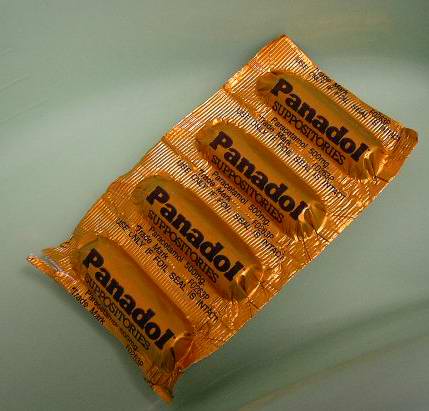Suppository

A suppository is a drug delivery system that is inserted either into the rectum (rectal suppository), vagina (vaginal suppository) or urethra (urethral suppository) where it dissolves. They are used to deliver both systemically-acting and locally-acting medications. The alternative term for delivery of medicine via such routes, is known as a pharmaceutical pessary.
The general principle is that the suppository is inserted as a solid, and will dissolve inside the body to deliver the medicine. (The phrase liquid suppository is also sometimes applied to small syringes injecting a liquid, typically a laxative, into the rectum.)
Vaginal suppositories are commonly used to treat gynaecological ailments, including vaginal infections such as candidiasis.
Rectal suppositories are commmonly used for:
- For laxative purposes, with chemicals such as glycerin or bisacodyl.
- To treat a hemorrhoid by delivering a moisturizer or vasoconstrictor.
- Delivery of many other systemically-acting medications, such as promethazine or aspirin.
- For general medical administration purposes: the substance crosses the rectal mucosa into the bloodstream; examples include paracetamol (acetaminophen), opiates, and eucalyptol suppositories.
Non-laxative rectal suppositories are to be used after defecation, so as not to be expelled before they are fully dissolved and the substance is absorbed.
Alprostadil pellets are urethral suppositories used for the treatment of severe erectile dysfunction. They are marketed under the name Muse in the United States.[1] Its use has diminished since the development of oral impotence medications, but is still on the market.
Some suppositories are made from a greasy base, such as cocoa butter, in which the active ingredient and other excipients are dissolved; this grease will melt at body temperature (this may be a source of discomfort for the patient[citation needed], as the melted grease may pass the anus during flatulences). Other suppositories are made from a water soluble base, such as polyethylene glycol. Suppositories made from polyethylene glycol are commonly used in vaginal and urethral suppositories. Glycerin suppositories are made of glycerol and gelatin.
Suppositories may be used for patients in the event it may be easier to administer than tablets or syrups. Suppositories may also be used when a patient has a stomach virus, and oral medication can be thrown up.
See also
Notes
- ↑ DrugDigest: Muse overview. Retrieved July 10, 2007.
References
- Abd-El-Maeboud, K.H., El-Naggar, T., El-Hawi, E.M.M., Mahmoud, S.A.R. & Abd-El-Hay, S., "Rectal Suppository: Commonsense and Mode of Insertion", The Lancet, Vol.338, No.8770, (28 September, 1991), pp.798–800.
- Doyle, D., "Per Rectum: A History of Enemata", Journal of the Royal College of Physicians of Edinburgh, Vol.35, No.4, (December 2005), pp.367-370.
- Payer, L., "How Medical Practice Reflects National Culture", The Sciences, Vol.30, No.4, (July-August 1990), pp.38-42.
cs:Čípek (léčivo) de:Suppositorium nl:Zetpil no:Stikkpiller fi:Suppo sv:Stolpiller